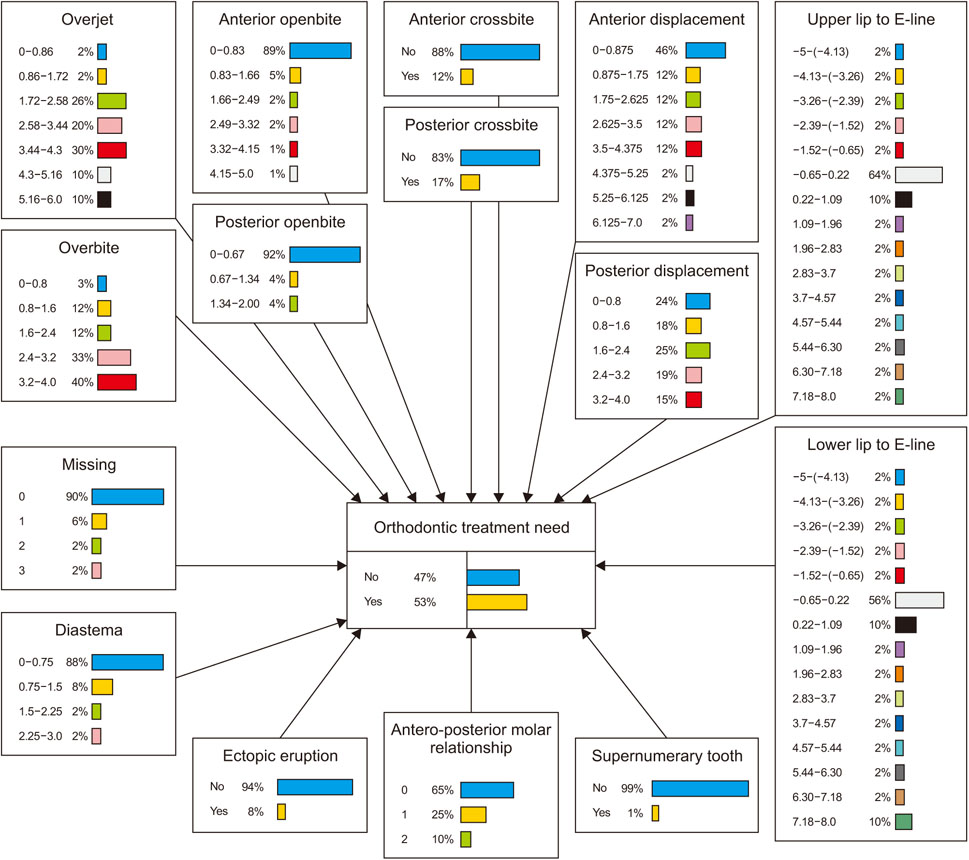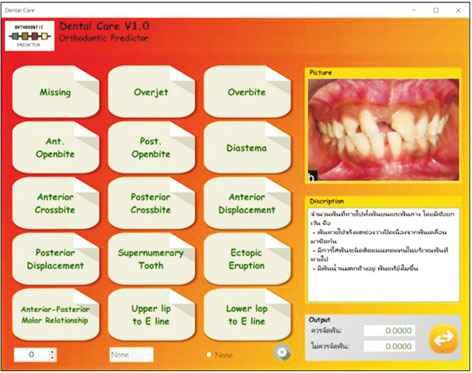Healthc Inform Res.
2018 Jan;24(1):22-28. 10.4258/hir.2018.24.1.22.
Bayesian-Based Decision Support System for Assessing the Needs for Orthodontic Treatment
- Affiliations
-
- 1Department of General Dentistry, Faculty of Dentistry, Srinakharinwirot University, Bangkok, Thailand. ppeetakul@hotmail.com
- KMID: 2403292
- DOI: http://doi.org/10.4258/hir.2018.24.1.22
Abstract
OBJECTIVES
In this study, a clinical decision support system was developed to help general practitioners assess the need for orthodontic treatment in patients with permanent dentition.
METHODS
We chose a Bayesian network (BN) as the underlying model for assessing the need for orthodontic treatment. One thousand permanent dentition patient data sets chosen from a hospital record system were prepared in which one data element represented one participant with information for all variables and their stated need for orthodontic treatment. To evaluate the system, we compared the assessment results based on the judgements of two orthodontists to those recommended by the decision support system.
RESULTS
In a BN decision support model, each variable is modelled as a node, and the causal relationship between two variables may be represented as a directed arc. For each node, a conditional probability table is supplied that represents the probabilities of each value of this node, given the conditions of its parents. There was a high degree of agreement between the two orthodontists (kappa value = 0.894) in their diagnoses and their judgements regarding the need for orthodontic treatment. Also, there was a high degree of agreement between the decision support system and orthodontists A (kappa value = 1.00) and B (kappa value = 0.894).
CONCLUSIONS
The study was the first testing phase in which the results generated by the proposed system were compared with those suggested by expert orthodontists. The system delivered promising results; it showed a high degree of accuracy in classifying patients into groups needing and not needing orthodontic treatment.
Keyword
MeSH Terms
Figure
Cited by 1 articles
-
Clinical Decision Support Functions and Digitalization of Clinical Documents of Electronic Medical Record Systems
Young-Taek Park, Yeon Sook Kim, Byoung-Kee Yi, Sang Mi Kim
Healthc Inform Res. 2019;25(2):115-123. doi: 10.4258/hir.2019.25.2.115.
Reference
-
1. Salzmann JA. Handicapping malocclusion assessment to establish treatment priority. Am J Orthod. 1968; 54(10):749–765.
Article2. Brook PH, Shaw WC. The development of an index of orthodontic treatment priority. Eur J Orthod. 1989; 11(3):309–320.
Article3. Richmond S, Shaw WC, Roberts CT, Andrews M. The PAR Index (Peer Assessment Rating): methods to determine outcome of orthodontic treatment in terms of improvement and standards. Eur J Orthod. 1992; 14(3):180–187.
Article4. Gardner JW, Stewart WH. Orthodontic treatment priority index. Washington (DC): US Department of Health, Education, and Welfare;1967.5. Summers CJ. The occlusal index: a system for identifying and scoring occlusal disorders. Am J Orthod. 1971; 59(6):552–567.
Article6. Cons NC, Jenny J, Kohout FJ. DAI: the dental aesthetic index. Iowa City (IA): College of Dentistry, University of Iowa;1986.7. Richmond S, Daniels CP. International comparisons of professional assessments in orthodontics. Part 1. Treatment need. Am J Orthod Dentofacial Orthop. 1998; 113(2):180–185.
Article8. Espeland LV, Ivarsson K, Stenvik A. A new Norwegian index of orthodontic treatment need related to orthodontic concern among 11-year-olds and their parents. Community Dent Oral Epidemiol. 1992; 20(5):274–279.
Article9. Grippaudo C, Paolantonio EG, Torre GL, Gualano MR, Oliva B, Deli R. Comparing orthodontic treatment need indexes. Italian J Public Health. 2008; 5(3):181–186.10. Johansson AM, Follin ME. Evaluation of the Dental Health Component, of the Index of Orthodontic Treatment Need, by Swedish orthodontists. Eur J Orthod. 2009; 31(2):184–188.
Article11. Shortliffe EH. Testing reality: the introduction of decision-support technologies for physicians. Methods Inf Med. 1989; 28(1):1–5.
Article12. Chae YM, Yoo KB, Kim ES, Chae H. The adoption of electronic medical records and decision support systems in Korea. Healthc Inform Res. 2011; 17(3):172–177.
Article13. Xie X, Wang L, Wang A. Artificial neural network modeling for deciding if extractions are necessary prior to orthodontic treatment. Angle Orthod. 2010; 80(2):262–266.
Article14. Akcam MO, Takada K. Fuzzy modelling for selecting headgear types. Eur J Orthod. 2002; 24(1):99–106.
Article15. Pearl J. Probabilistic reasoning in intelligent systems: networks of plausible inference. San Francisco (CA): Morgan Kaufmann;1988.16. Suebnukarn S, Rungcharoenporn N, Sangsuratham S. A Bayesian decision support model for assessment of endodontic treatment outcome. Oral Surg Oral Med Oral Pathol Oral Radiol Endod. 2008; 106(3):e48–e58.
Article17. Thanathornwong B, Suebnukarn S, Songpaisan Y, Ouivirach K. A system for predicting and preventing work-related musculoskeletal disorders among dentists. Comput Methods Biomech Biomed Engin. 2014; 17(2):177–185.
Article18. Choi JP, Han TH, Park RW. A hybrid Bayesian network model for predicting breast cancer prognosis. J Korean Soc Med Inform. 2009; 15(1):49–57.
Article19. Su C, Andrew A, Karagas MR, Borsuk ME. Using Bayesian networks to discover relations between genes, environment, and disease. BioData Min. 2013; 6(1):6.
Article20. Corani G, Magli C, Giusti A, Gianaroli L, Gambardella LM. A Bayesian network model for predicting pregnancy after in vitro fertilization. Comput Biol Med. 2013; 43(11):1783–1792.
Article21. Wang XH, Zheng B, Good WF, King JL, Chang YH. Computer-assisted diagnosis of breast cancer using a data-driven Bayesian belief network. Int J Med Inform. 1999; 54(2):115–126.
Article22. Faure JC, Rieffe C, Maltha JC. The influence of different facial components on facial aesthetics. Eur J Orthod. 2002; 24(1):1–7.
Article23. Alcalde RE, Jinno T, Pogrel MA, Matsumura T. Cephalometric norms in Japanese adults. J Oral Maxillofac Surg. 1998; 56(2):129–134.
Article24. Chu YM, Bergeron L, Chen YR. Bimaxillary protrusion: an overview of the surgical-orthodontic treatment. Semin Plast Surg. 2009; 23(1):32–39.
Article25. Hayashi K, Saitoh S, Mizoguchi I. Morphological analysis of the skeletal remains of Japanese females from the Ikenohata-Shichikencho site. Eur J Orthod. 2012; 34(5):575–581.
Article
- Full Text Links
- Actions
-
Cited
- CITED
-
- Close
- Share
- Similar articles
-
- Clinical Decision Support System for Geriatric Dental Treatment Using a Bayesian Network and a Convolutional Neural Network
- Part I. What drives Korean adults to seek orthodontic treatment: Reliability and validity of a measurement instrument for the perception of orthodontic treatment
- The clinical decision analysis using decision tree
- Expert System Shells for Rapid Clinical Decision Support Module Development: An ESTA Demonstration of a Simple Rule-Based System for the Diagnosis of Vaginal Discharge
- Development of a Decision Support System for Analysis and Solutions of Prolonged Standing in the Workplace



